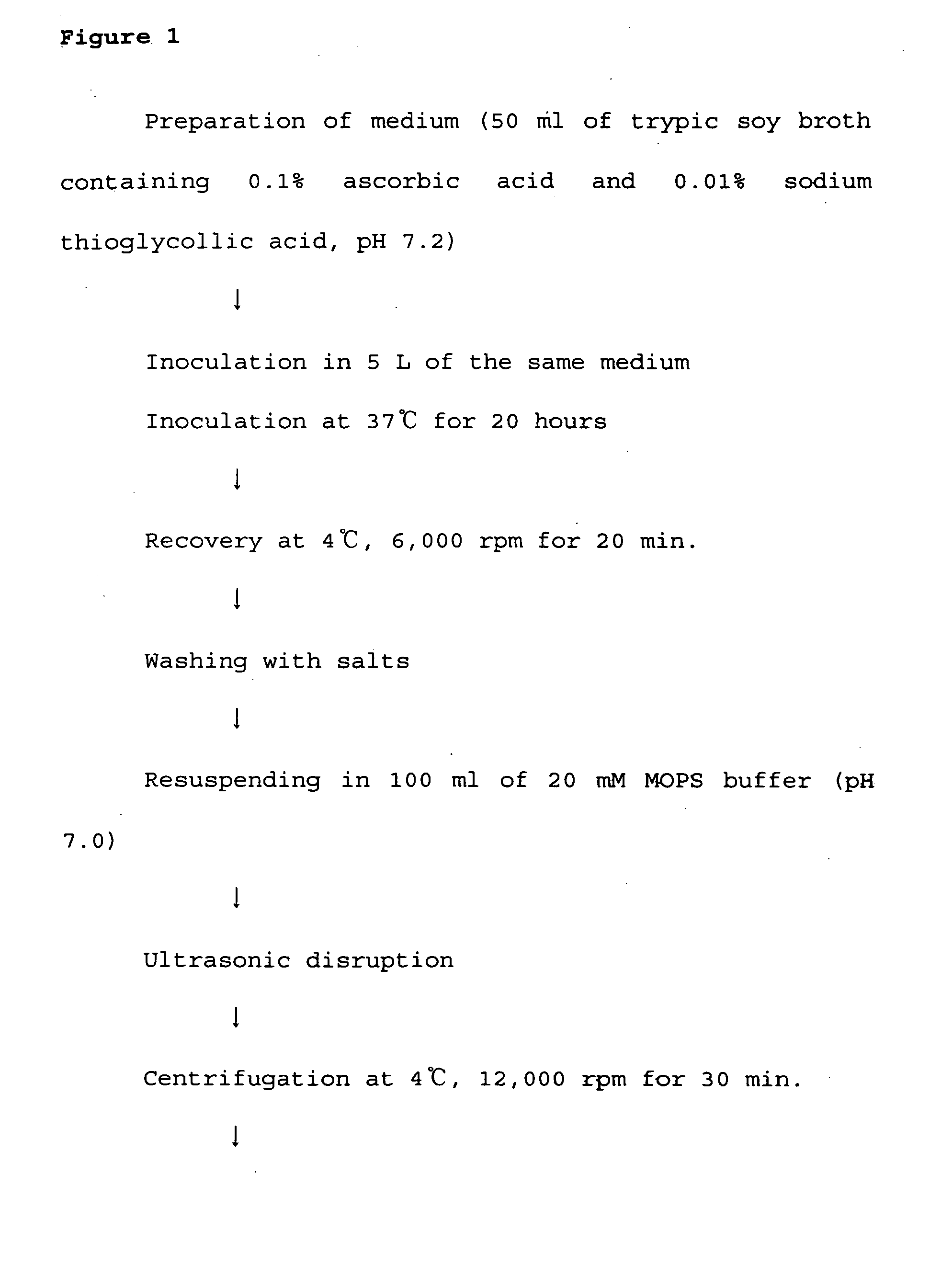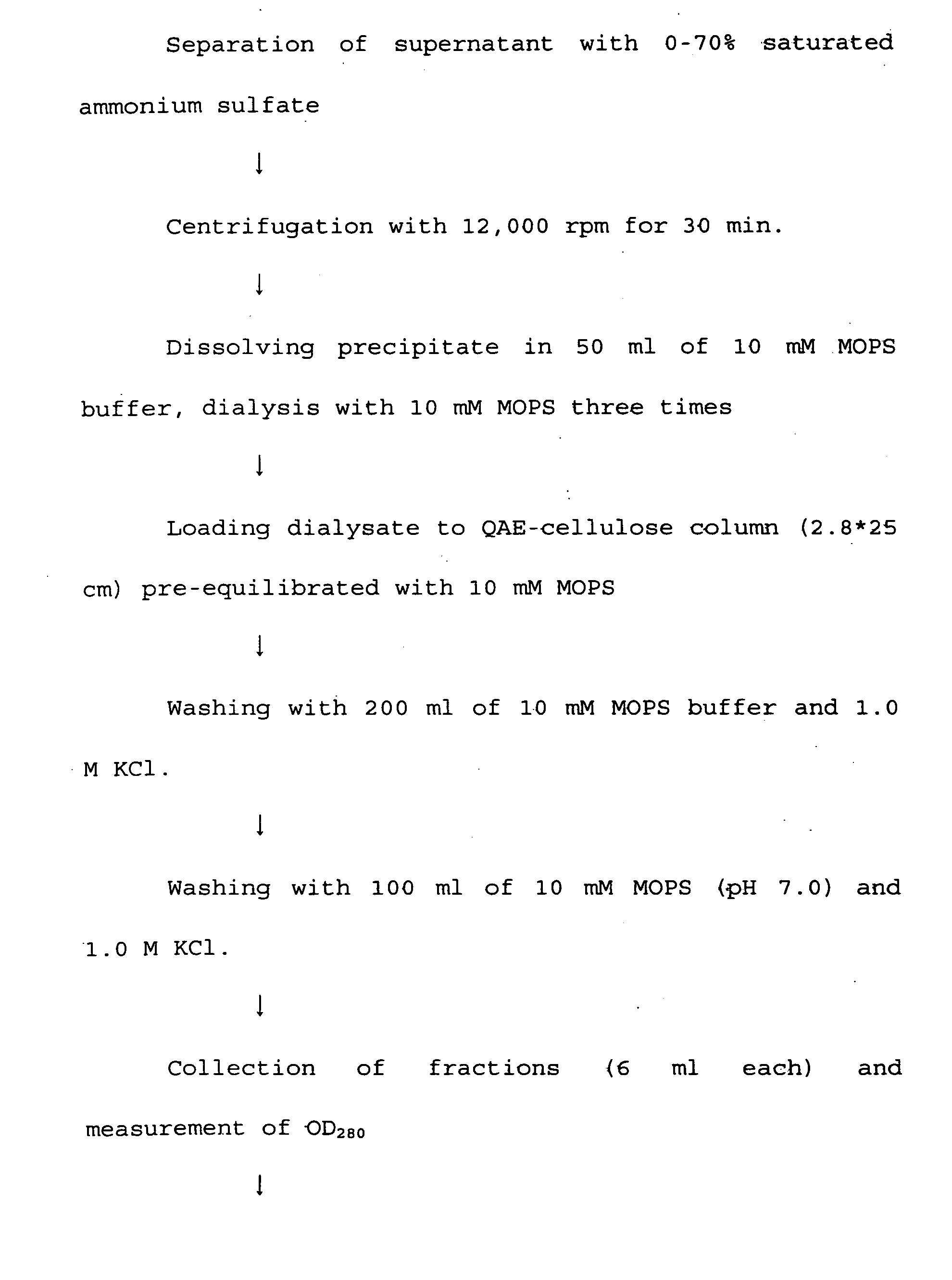Bifidobacterium longum AR81 (KCCM-10492) enabling inhibition of rotavirus and active protein separated therefrom
a technology of bifidobacterium longum and kccm-10492, which is applied in the field of new strains, can solve the problems of infant mortality, difficult for patients of developing countries to be treated simply with water, and diarrhoea that has not yet come ou
- Summary
- Abstract
- Description
- Claims
- Application Information
AI Technical Summary
Benefits of technology
Problems solved by technology
Method used
Image
Examples
example 2
[0037] Distribution of Rotavirus and Preparation of the Virus Solution
[0038] SA11 rotavirus was provided from National Institute of Health (NIH), Korea and Wa rotavirus was provided from ATCC.
[0039] Each virus was distributed into T.C. flasks (25 cm2) by the concentration of 1-2×106 cells / flask, then cells were adhered for one hour under the condition of 37° C. and 5% CO2.
[0040] Supernatant was removed and the cells were washed with FBS-free DMEM medium. 20 μl of DMEM medium (infectious medium) containing 5 μg / ml of trypsin was added to 400 μl of Wa virus or SA11 virus solution, which was treated at 37° C. for 30 minutes. 400 μl of pre-activated Wa virus solution was spread over the cell surface evenly, leading to infection at 37° C. for one hour.
[0041] Upon completing the infection, supernatant was removed and cytopathic effect (cpe) was investigated. After confirmation, it was frozen.
[0042] Freezing-thawing was repeated three times to break the cell membrane completely. Centr...
example 3
[0043]Lactobacillus and Bifidobacterium used in the Present Invention
[0044]Lactobacillus acidophilus KCTC 3150, Bifidobacterium longum KCTC 3215 and Bifidobacterium infantis KCTC 3226 used in the present invention were provided from Institute of Genetic Engineering, Korea, and the rest of the strains used in the invention were separated from bacterial flora residing in the human intestines.
example 4
[0045] Determination of Titer of Rotavirus Solution
(End-Point Dilution Method)
[0046] MA-104 cells cultured in the above Example 1 were treated with 0.25% trypsin-EDTA to isolate them. Then, a fresh medium was provided. Centrifugation was performed at 1200 rpm for 5 minutes to discard supernatant. Cell concentration was adjusted to 5×105 cells / ml using infectious medium.
[0047] Rotavirus stock solution was serially diluted from 10−1 to 10−8, and each diluted solution was distributed to 8 wells by 100 μl.
[0048] The cultured MA-104 cells were distributed thereto by the same amount, followed by further culture in a 37° C., 5% CO2 incubator for 7 days.
[0049] Upon completing the culture, cpe of each well was investigated under inverted microscope to calculate TCID50 (50% Tissue-culture infectious dose) / ml. Pfu (plaque forming unit) / ml was calculated by multiplying the value of TCID50 / ml by a coefficient 0.69.
PUM
| Property | Measurement | Unit |
|---|---|---|
| Strain point | aaaaa | aaaaa |
Abstract
Description
Claims
Application Information
 Login to View More
Login to View More - R&D
- Intellectual Property
- Life Sciences
- Materials
- Tech Scout
- Unparalleled Data Quality
- Higher Quality Content
- 60% Fewer Hallucinations
Browse by: Latest US Patents, China's latest patents, Technical Efficacy Thesaurus, Application Domain, Technology Topic, Popular Technical Reports.
© 2025 PatSnap. All rights reserved.Legal|Privacy policy|Modern Slavery Act Transparency Statement|Sitemap|About US| Contact US: help@patsnap.com



